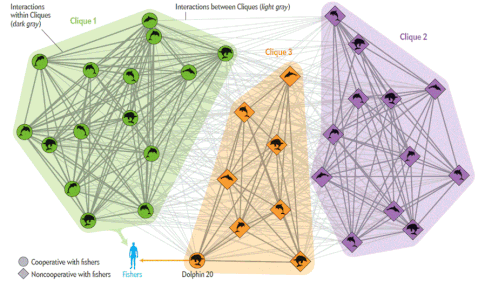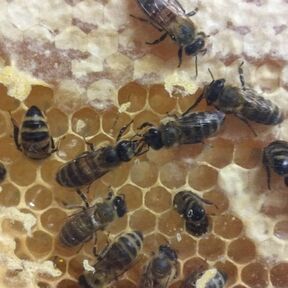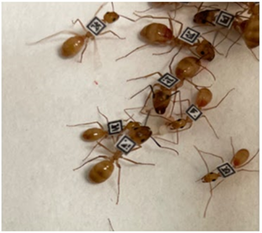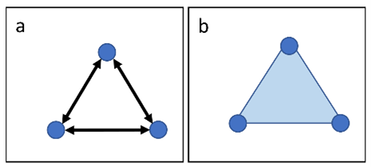Animal social networks
 Fig. 1. From: Dugatkin & Hasenjager (2015)
Fig. 1. From: Dugatkin & Hasenjager (2015)
Social groups can be conceptualized as networks in which the connections between individuals represent interactions or social relationships [1]. These patterns of connectivity and how they change over time can have important ecological and evolutionary consequences. For example, when populations are subdivided into tightly knit communities (as in the dolphin network shown here), this can potentially constrain the spread of behavioral innovations across communities, while facilitating rapid transmission within them [2].
1. Hasenjager MJ, Dugatkin LA. 2015. Social network analysis in behavioral ecology. Advances in the Study of Behavior 47, 39-114. doi: 10.1016/bs.asb.2015.02.003
2. Dugatkin LA, Hasenjager M. 2015. The Networked Animal. Scientific American, June 2015, pp. 50-55. doi: 10.1038/scientificamerican0615-50
1. Hasenjager MJ, Dugatkin LA. 2015. Social network analysis in behavioral ecology. Advances in the Study of Behavior 47, 39-114. doi: 10.1016/bs.asb.2015.02.003
2. Dugatkin LA, Hasenjager M. 2015. The Networked Animal. Scientific American, June 2015, pp. 50-55. doi: 10.1038/scientificamerican0615-50
Environmental drivers of network structure and function
 Fig. 2. El Cedro River, Arima, Trinidad
Fig. 2. El Cedro River, Arima, Trinidad
Social network structure emerges from the patterning of interactions among individuals. For my doctoral work with Lee Dugatkin at the University of Louisville, I investigated how environmental factors, such as predation risk and group composition, modulated the social network structure of shoals of Trinidadian guppies (Poecilia reticulata) and influenced the spread of foraging information. For example, I found that high perceived predation risk generated guppy networks that were strongly assorted by body size and drove individuals to explore their environment in the company of preferred social partners [1]. In addition, I found that how individuals learned was contingent not only on their own risk-taking tendency, but on that of their group mates [2]. In other words, group personality composition can shape how information spreads among individuals.
1. Hasenjager MJ, Dugatkin LA. 2017. Fear of predation shapes social network structure and the acquisition of foraging information in guppy shoals. Proceedings of the Royal Society B 284, 20172020. doi: 10.1098/rspb.2017.2020
2. Hasenjager MJ, Hoppitt W, Dugatkin LA. 2020. Personality composition determines social learning pathways within shoaling fish. Proceedings of the Royal Society B 287, 20201871. doi: 10.1098/rspb.2020.1871
1. Hasenjager MJ, Dugatkin LA. 2017. Fear of predation shapes social network structure and the acquisition of foraging information in guppy shoals. Proceedings of the Royal Society B 284, 20172020. doi: 10.1098/rspb.2017.2020
2. Hasenjager MJ, Hoppitt W, Dugatkin LA. 2020. Personality composition determines social learning pathways within shoaling fish. Proceedings of the Royal Society B 287, 20201871. doi: 10.1098/rspb.2020.1871
Honeybee communication networks

Fig. 3. Nectar exchange during trophallaxis
The honeybee (Apis mellifera) waggle dance allows successful foragers to transmit the location of profitable resources to their nestmates. However, elucidating the functional relevance of this remarkable ability to a colony's foraging efforts has proven challenging. Disrupting dances often has little impact on the amount of food that a colony is able to collect and honeybees can use alternative sources of information to aid in locating food [1]. As a postdoctoral researcher with Elli Leadbeater at Royal Holloway, University of London, I investigated how different communication networks (e.g. dance-following, olfactory communication) were integrated under different foraging conditions by combining social network analyses [2] with experimental manipulations of feeder arrays. For instance, I compared honeybees' relative reliance on waggle dances versus olfactory communication in two key foraging contexts: recruitment to novel locations and reactivation to previously visited sites. I found that dances were key for recruitment, but that reactivation (which is far more common during daily foraging) was driven primarily by non-dance interactions [3]. These findings illustrate why disrupting dances often has limited impacts on foraging, as most dance-following occurs in contexts for which other social transmission pathways are similarly useful. This work further highlights how key properties of honeybee communication (e.g., signals with multiple functions, communication systems that overlap in function) confer robustness and efficiency to colony foraging efforts.
1. Leadbeater E, Hasenjager MJ. 2019. Honeybee communication: There's more on the dancefloor. Current Biology 29, R285-R287. doi: 10.1016/j.cub.2019.03.009
2. Hasenjager MJ, Leadbeater E, Hoppitt W. 2021. Detecting and quantifying social transmission using network-based diffusion analysis. Journal of Animal Ecology, 90, 8-26. doi: 10.1111/1365-2656.13307
3. Hasenjager MJ, Hoppitt W, Leadbeater E. 2020. Network-based diffusion analysis reveals context-specific dominance of dance communication in foraging honeybees. Nature Communications 11, 625. doi: 10.1038/s41467-020-14410-0
1. Leadbeater E, Hasenjager MJ. 2019. Honeybee communication: There's more on the dancefloor. Current Biology 29, R285-R287. doi: 10.1016/j.cub.2019.03.009
2. Hasenjager MJ, Leadbeater E, Hoppitt W. 2021. Detecting and quantifying social transmission using network-based diffusion analysis. Journal of Animal Ecology, 90, 8-26. doi: 10.1111/1365-2656.13307
3. Hasenjager MJ, Hoppitt W, Leadbeater E. 2020. Network-based diffusion analysis reveals context-specific dominance of dance communication in foraging honeybees. Nature Communications 11, 625. doi: 10.1038/s41467-020-14410-0
Ant-inspired design of supply networks
 Fig. 4. Ant workers (C. fragilis) individually marked with BEEtags. Image credit: Noa Pinter-wollman.
Fig. 4. Ant workers (C. fragilis) individually marked with BEEtags. Image credit: Noa Pinter-wollman.
Social insect colonies produce coordinated collective responses with a robustness and flexibility that often exceeds that of human-designed systems [1]. For example, ant colonies enact efficient, demand-driven food distribution under dynamic and uncertain foraging conditions based solely on local decision-making by workers. As a postdoctoral researcher with Nina Fefferman at the University of Tennessee, Knoxville, I used agent-based modeling to investigate how functional elements derived from ant systems could be applied to enhance human supply network stability. With collaborators at UCLA (https://pinterwollmanlab.eeb.ucla.edu/), we analyzed food distribution networks in carpenter ants (Camponotus fragilis) confronted with experimental disruptions to their food supply [2]. I then designed decision-making algorithms guided by the ants behavior and evaluated their impacts using computational experiments. I found that under many contexts, these algorithms were able to enhance the robustness of simulated supply networks to disruption [3].
1. Hasenjager MJ, Guo X, Pinter-Wollman N, Fefferman N. Designing sustainable systems using nature's toolbox. Submitted.
2. Guo X, Hasenjager MJ, Fefferman N, Pinter-Wollman N. Social interactions are impacted by food availability, food type, and group size. Submitted.
3. Hasenjager MJ, Derryberry G, Guo X, Pinter-Wollman N, Fefferman N. Nature-inspired design principles promote supply network stability. Submitted.
1. Hasenjager MJ, Guo X, Pinter-Wollman N, Fefferman N. Designing sustainable systems using nature's toolbox. Submitted.
2. Guo X, Hasenjager MJ, Fefferman N, Pinter-Wollman N. Social interactions are impacted by food availability, food type, and group size. Submitted.
3. Hasenjager MJ, Derryberry G, Guo X, Pinter-Wollman N, Fefferman N. Nature-inspired design principles promote supply network stability. Submitted.
Social transmission in hypernetworks
 Fig. 5. (a) Traditional networks cannot distinguish three pairwise interactions from one three-way interaction. (b) A hyperedge that denotes a three-way interaction. Hypernetworks can also encode pairwise interactions as in (a).
Fig. 5. (a) Traditional networks cannot distinguish three pairwise interactions from one three-way interaction. (b) A hyperedge that denotes a three-way interaction. Hypernetworks can also encode pairwise interactions as in (a).
A limitation of traditional network approaches is that they cannot distinguish between interactions that are strictly dyadic and those that involve three or more individuals (referred to as higher-order interactions). For example, a simultaneous conversation among Alice, Bob, and Charlotte shares an identical network representation as three separate conversations among these individuals (i.e., between Alice and Bob, Alice and Charlotte, and Bob and Charlotte) (Fig. 5a). However, multi-way interactions can fundamentally alter the outcomes of social processes such as social learning, disease transmission, and communication. Hypernetworks and related approaches (e.g., simplicial sets) are able to distinguish dyadic from higher-order interactions, yet the tools that are available to describe and analyze them remain limited. As an Intelligence Community Postdoctoral Fellow, I am currently developing computational tools for measuring centrality in complex, dynamic hypernetworks and applying them to investigate how multi-way interactions impact innovation and social transmission within groups.
